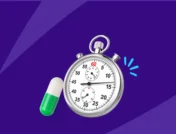When you’re struggling with anxiety, chances are one of the first things your doctor will recommend is exercise, and for good reason. Activity that gets your body moving will improve your mood, distract you, and get those feel-good brain chemicals flowing.
But what if you’re too anxious to even get to the gym? Sometimes anxiety requires more than one approach, which is where psychotropic drugs like Xanax come in. Before you pop a pill and hit the gym, it’s important to consider whether or not working out on Xanax—or any anti-anxiety medication—is safe.
RELATED: What is Xanax? | Get Xanax coupon
What’s Xanax?
Xanax (alprazolam) is prescribed to treat panic attacks, generalized anxiety, and other panic disorders on a short-term basis. The popular anti-anxiety drug is classified as a benzodiazepine, which is a controlled substance that can be highly addictive and can even lead to an overdose. Xanax acts quickly once you’ve taken it, which makes it useful for panic attacks; it also leaves your system relatively quickly, depending on factors like metabolism, age, weight, and dose.
You should also discuss with your doctor what activities are safe to do while on Xanax, including what types of exercise are okay.
Potential side effects of Xanax and exercise
Once you get the go-ahead from your doctor, there are a number of factors to keep in mind. Xanax is effective at curbing anxiety for the same reasons it can make working out more difficult or even dangerous: It makes you sleepy and less coordinated, which can be compounded by exercising. It’s important to make sure you don’t overextend yourself, even if you’re a seasoned gym-goer.
“[Xanax] also decreases energy, increases muscle relaxation, and may cause drowsiness due to its sedative effects,” Crystal Clark, MD, MSc, Associate Professor of Psychiatry and Behavioral Sciences at Northwestern Medicine explains. “These side effects can impact your ability to work out safely and effectively and should be discussed with your doctor first.”
There are also factors at play, according to Aaron Emmel, Pharm.D., program director at Pharmacy Tech Scholar, such as “the individual, the dose, and the duration of treatment. For example, a young adult at low risk for falls who is stable on a low dose of Xanax to treat generalized anxiety disorder may be able to exercise perfectly fine. An older adult who is temporarily taking Xanax could be at risk for falls and injury due to the psychomotor impairment that alprazolam can cause.” However, antidepressants that treat anxiety, like, Paxil, Prozac, Zoloft, and Effexor, don’t necessarily have the same sedating side effects. Daily use of these antidepressants to help treat anxiety may decrease the number of panic attacks, and therefore decrease the need for drugs such as Xanax.
Xanax, exercise, and supplements
Once you really get into exercising, you might be tempted to experiment with pre-workout supplements and the like. However, even if you’re not on Xanax or other prescription medications, you should think twice before investing in expensive powders and pills. Dietary supplements aren’t regulated as stringently by the FDA as other food and drugs, and may have adverse side effects even if you’re in the best of health.
“Pre-workout supplements are not well studied, so it’s hard to determine if there is potential for metabolism-related interactions,” Dr. Emmel says. “However, I’d note that individuals who are taking Xanax for anxiety are high risk for adverse effects from pre-workout supplements.” This is especially true since some supplements have stimulating and/or vasodilating effects, which can cause light-headedness even if you’re not taking Xanax.
Exercise and anxiety
It’s hard to think about exercising when you’re experiencing anxiety, but there are plenty of reasons why it’s one of the first things doctors suggest to cope. It forces you to think about something other than what you’re anxious about. There are no side effects, and you don’t need to spend a lot of money doing it, although plenty of people do. (If you have a history of disordered eating or exercising, it’s also important to discuss that with your doctor before embarking upon a new exercise regimen.)
Even if you don’t like the act of exercising, you’ll feel much better afterward—it’s science! As Dr. Clark explains, “Exercise beneficially impacts the brain endorphins as well as neurotransmitters such as serotonin, norepinephrine, and dopamine to reduce anxiety. Regular exercise (30 minutes, three times every week), especially cardio, is recommended to reduce anxiety and boost mood. This can occur immediately after exercising but is only sustained with regular use.”
However, if you don’t thrive on cardio, there are plenty of other exercises that are just as beneficial. Dr. Emmel suggests, “Some of the best evidence exists for specific types of exercise that combine physical activity with meditation and mindfulness: yoga and tai-chi.”
You should also talk to your doctor about what sorts of exercise is the best for you personally. Additionally, you’ll want to be extra careful doing anything that incorporates heavy weights or requires coordination until you’re sure Xanax isn’t affecting your performance.
Exercise is hugely beneficial when it comes to regulating your mood and anxiety, but with guidance from a trusted doctor, it is possible to use Xanax and exercise on a short-term basis.











